BDI Designs Address Evolving Home Theater Trends
CHANTILLY, Va. -- Far from the days when the TV was content to sit on any table or open rack, consumers today are looking for fully-featured furniture solutions for their home theater to match the latest technology. In a year where 3D-TV and Internet-connectivity have gained ground in homes, home theater furniture design continues to evolve to maximize the potential of cutting-edge displays, electronic components and features.
Furniture manufacturer BDI is an industry leader in home theater furniture that is designed to seamlessly integrate technology into the home. "More consumers are looking for full-featured furniture solutions for their home theater," says Bill Becker, BDI's Design Director and CEO. "Beyond the place where the family comes together to be entertained, studies show that the family room is second only to the kitchen as the most occupied room of the house. This, combined with all of the 'cool' new technology, has created a renewed enthusiasm for a fully integrated home theater environment."
While many are dismissing new 3D-TV technology as a mere trend, recent reports from DisplaySearch show that the immersive television experience will soon be the mainstream technology. By 2014, 3D-TV will reach over 90 million shipments. This would mean that 3D would grow from 2 percent of all flat panel TVs shipped in 2011 to 41 percent in 2014.3D television broadcast channels from ESPN, Discovery and Direct TV are already a reality, according to the DIY Network.
But accommodating 3D-TV will be a challenge for interior designers. The same DIY Network story reports that TV manufacturers are only offering the technology on sets larger than 40 inches, in order to maximize the impact of the imagery. This can make choosing a cabinet difficult, as it must accommodate the television's size and its accompanying equipment, while staying compact as not to interfere with the illusion created above.
At the same time, Internet connectivity and streaming video have turned into a mainstay for digital entertainment, according to About.com. New connected "smart TVs" from companies such as Samsung and LG debuted at the 2011 CES equipped with their own app stores, including games and streaming videos. These TVs, which DisplaySearch expects to grow to 11 million units by 2014, come packed with features but at a high price, as with any early adopter tech. Consumers can also opt to purchase Internet-enabled devices like Blu-Ray players to enable online content. Digital Trends has reported that companies like Motorola are even developing social media applications for television, which will provide companion content like games, special offers, live chat, or targeted advertising.
In comparison to 3D-TV, connected TVs will require their own room design, with storage for extra routers and cords. Those that choose to add a Blu-Ray player or other Internet connected hardware rather than pay for a fully connected TV will also need an elegant disguise for their accompanying devices without interfering with the technology's longevity.
To address some of these trending issues, BDI has designed a collection of home theater furniture that can adapt to and accommodate the new dynamic technology. BDI's Arena TV Mount 9970, for example, was designed to mount a 40" - 60" flat panel television to almost any of the company's home theater cabinets. Arena's spine features a channel for routing, so cords can easily and neatly stay hidden out of plain sight, while the universal mounting bracket also providing a swivel option. Consumers can use the pre-set height adjustments to match their line of sight with the television, an essential for those that depend on matching the TV signal to the 3D glasses. Others like the new Cascadia home theater cabinets use an IR remote-friendly, grey tinted glass flip-down door that keeps components neatly out of sight. With three enclosed component compartments, the cabinet includes an open shelf for use with a soundbar or center speaker and/or additional components.
"Consumers are looking for furniture that will present their TV and latest technology in style while concealing many of the other components such as DVDs, gaming consoles, speakers and accessories," says Becker. "Beyond being able to accommodate - and show off - the hottest new components, furniture for home theater must also include features that maximize the functionality and longevity of high-dollar systems. This includes features like hidden wheels for easy access to the rear of components, flow-through ventilation to keep air circulating, adjustable shelves for versatile setup, convenient media or speaker storage, and integrated cable management systems to keep wires under control."
Becker adds, "As the economy has lagged in recent years, more families are staying in and enjoying their home theaters as opposed to taking the entire family out to a movie or other entertainment. In response, home theater systems have evolved to deliver the true 'theater' experience at home."
About BDI:
Since 1984, BDI has been driven by a passion for great design. BDI furniture is designed to seamlessly integrate technology into the home. BDI home theater cabinets, office, tables and mirrors collections set the standard by beautifully combining unique styling with thoughtful engineering, earning a reputation in the industry for innovation and quality. Visit BDI online at www.bdiusa.com. Follow BDI on Facebook and check out the latest tips on selecting office furniture.

Комментариев нет:
Отправить комментарий